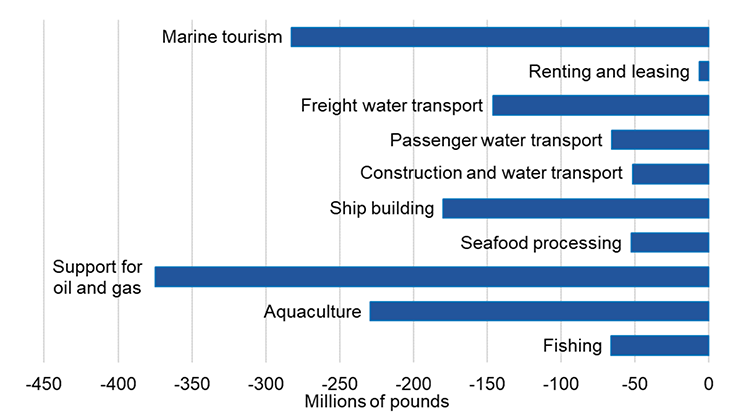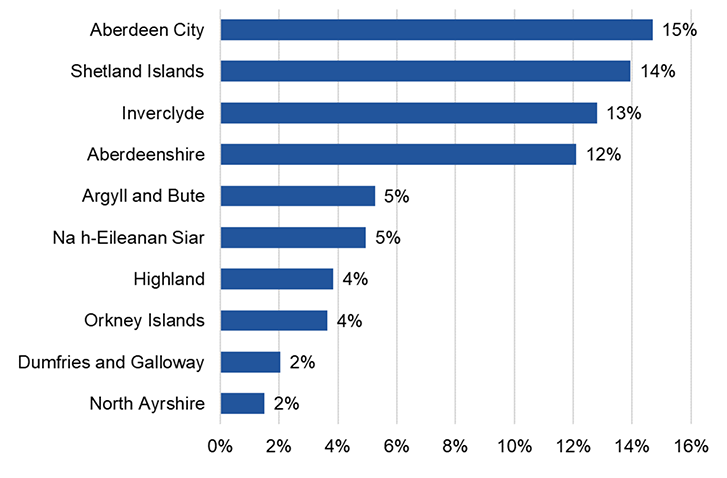Scotland's Marine Economic Statistics 2020
Statistics on the economic contributions of Scotland’s marine sectors in 2020. Includes a time series of Gross Value Added (GVA), turnover and employment for marine sectors. The supporting documents include: additional tables in an excel file and a pdf version of the publication.
This document is part of a collection
Marine economy overview
Marine economy key points
In 2020, the Scottish marine economy generated £4 billion in GVA. This accounted for 2.8% of the total Scottish economy. The Scottish marine economy provided employment for 68,600 people. This was 2.6% of the total Scottish employment.
Support for oil and gas has the biggest marine economy turnover and GVA. But, marine tourism employs the most people of all the sectors covered in this report. Support for oil and gas provide 43% of the marine economy GVA. But, only 22% of the employment. Marine tourism provides 9% of the GVA and 39% of the employment.
Labour productivity (GVA per worker) varies across the marine economy. Freight water transport has the highest GVA per worker in 2020 (around £194,000). Marine tourism has the lowest at around £14,000.
Economic information on oil and gas extraction is not included in this report. See Annex for more information.
| Marine sector | GVA (millions of pounds) | Turnover (millions of pounds) | Employment headcount (thousands) | GVA per head (pounds) |
|---|---|---|---|---|
| Fishing | 284 | 512 | 4.3 | 65,774 |
| Aquaculture | 362 | 967 | 2.4 | 151,565 |
| Support for oil and gas | 1,692 | 4,710 | 15.0 | 112,773 |
| Seafood processing | 355 | 1,700 | 7.2 | 49,347 |
| Shipbuilding | 262 | 874 | 6.7 | 39,134 |
| Construction and water transport services | 408 | 612 | 4.3 | 94,930 |
| Passenger water transport | 75 | 272 | 1.6 | 47,000 |
| Freight water transport | 97 | 219 | 0.5 | 194,000 |
| Renting and leasing of water transport equipment | 9 | 15 | 0.1 | 90,000 |
| Marine tourism | 360 | 709 | 26.5 | 13,574 |
| Total | 3,904 | 10,589 | 68.6 | 56,910 |
Marine economy trends
Between 2019 and 2020, the marine economy's GVA decreased by 27% from £5.4 billion to £3.9 billion (2020 prices). Employment decreased by 9%. This decrease is the result of the lockdowns and restrictions imposed as a result of the Covid-19 pandemic.
Table 2 shows the longer term trend in the marine economy. Between 2011 and 2020 the marine economy GVA fell by 24%. Employment decreased by 1% between 2011 and 2020.
| Year | GVA (millions of pounds) | Turnover (millions of pounds) | Employment headcount (thousands) |
|---|---|---|---|
| 2011 | 5,163 | 13,815 | 69.4 |
| 2012 | 5,515 | 14,264 | 69.3 |
| 2013 | 5,524 | 14,789 | 73.5 |
| 2014 | 5,579 | 15,586 | 74.6 |
| 2015 | 5,361 | 15,116 | 78.7 |
| 2016 | 4,860 | 11,853 | 75.7 |
| 2017 | 5,695 | 12,788 | 74.1 |
| 2018 | 4,748 | 11,899 | 74.7 |
| 2019 | 5,359 | 12,360 | 75.3 |
| 2020 | 3,904 | 10,589 | 68.6 |
Figure 1 shows the change in GVA from 2019 to 2020. The GVA of all marine sectors fell between 2019 and 2020. Support for oil and gas and marine tourism had the largest decreases. The figures for the marine economy by sector are in Table 20.

Marine economy by geography
Marine economic information is available for most local authorities, subject to confidentiality considerations. Aberdeen City accounted for £1.4 billion (37%) of Scotland's marine economy's GVA for 2020 (Table 3).
Marine GVA and employment is particularly important to rural economies. Marine GVA contributes most to Aberdeen City, accounting for 15% of their total GVA in 2020 (Figure 2). Shetland Islands are a close second, with marine sectors contributing 14% of their GVA.

Contact
There is a problem
Thanks for your feedback